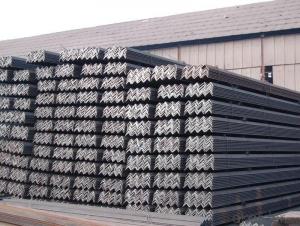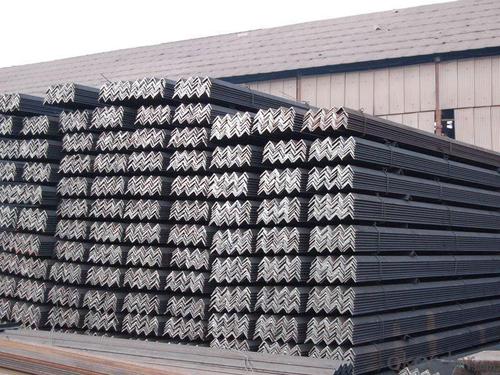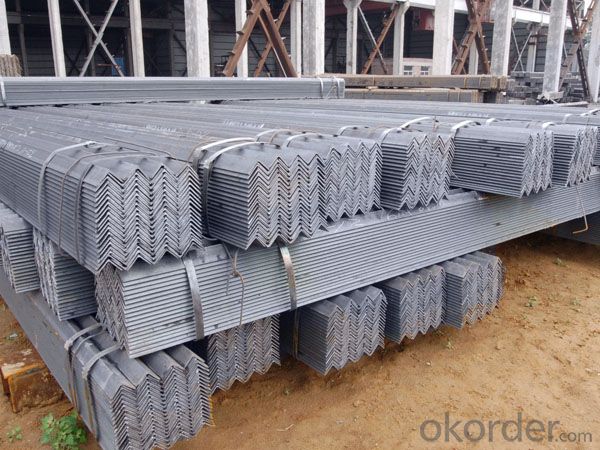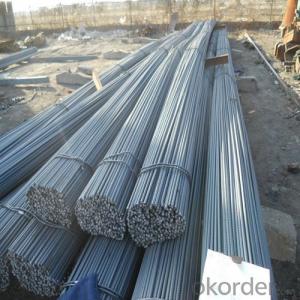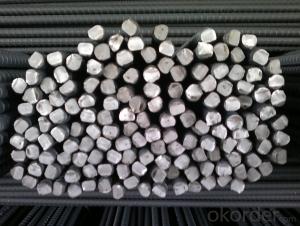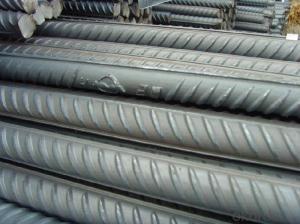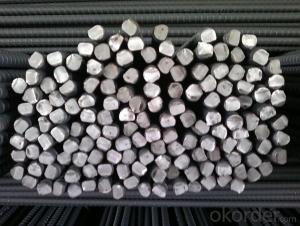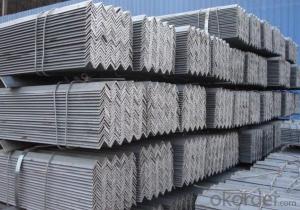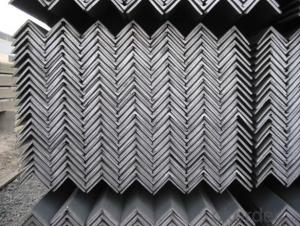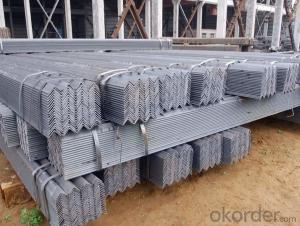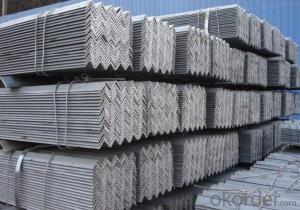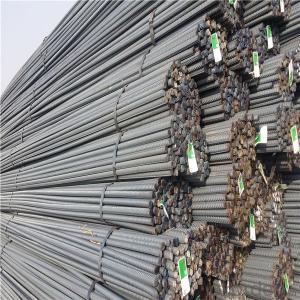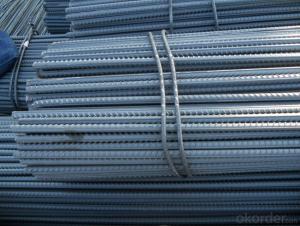ANGLE STEEL 80-250MM
- Loading Port:
- China Main Port
- Payment Terms:
- TT OR LC
- Min Order Qty:
- -
- Supply Capability:
- -
OKorder Service Pledge
OKorder Financial Service
You Might Also Like
Angle Steel Details:
| Minimum Order Quantity: | 25mtons | Unit: | m.t. | Loading Port: | China Main Port |
| Supply Ability: | 80000-100000MTS/YEAR | Payment Terms: | TT or LC |
Product Description:
Specifications of Angle Steel
1. Invoicing on theoretical weight or actual weight as customer request
2. Length: 6m, 9m, 12m as following table
3. Sizes
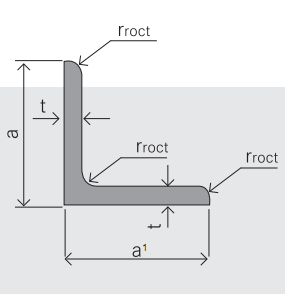
Sizes: 25mm-250mm | ||
a*t | ||
25*2.5-4.0 | 70*6.0-9.0 | 130*9.0-15 |
30*2.5-6.6 | 75*6.0-9.0 | 140*10-14 |
36*3.0-5.0 | 80*5.0-10 | 150*10-20 |
38*2.3-6.0 | 90*7.0-10 | 160*10-16 |
40*3.0-5.0 | 100*6.0-12 | 175*12-15 |
45*4.0-6.0 | 110*8.0-10 | 180*12-18 |
50*4.0-6.0 | 120*6.0-15 | 200*14-25 |
60*4.0-8.0 | 125*8.0-14 | 250*25 |
5. Payment terms:
1).100% irrevocable L/C at sight.
2).30% T/T prepaid and the balance against the copy of B/L.
3).30% T/T prepaid and the balance against L/C
6.Material details:
Alloy No | Grade | Element (%) | | ||||
C | Mn | S | P | Si | | ||
| | |||||||
|
|
|
|
|
|
| |
Q235 | B | 0.12—0.20 | 0.3—0.7 | ≤0.045 | ≤0.045 | ≤0.3 | |
|
|
|
|
|
|
| |
Alloy No | Grade | Yielding strength point( Mpa) | | ||||
Thickness (mm) | | ||||||
≤16 | >16--40 | >40--60 | >60--100 | | |||
≥ | | ||||||
|
|
|
|
|
| | |
Q235 | B | 235 | 225 | 215 | 205 | | |
Alloy No | Grade | Tensile strength (Mpa) | Elongation after fracture (%) | | |||
Thickness (mm) | | ||||||
| ≤16 | >16--40 | >40--60 | >60--100 | | ||
≥ | | ||||||
|
|
|
|
|
|
| |
Q235 | B | 375--500 | 26 | 25 | 24 | 23 | |
Usage & Applications of Angle Steel
According to the needs of different structures, Angle can compose to different force support component, and also can be the connections between components. It is widely used in various building structures and engineering structures such as roof beams, bridges, transmission towers, hoisting machinery and transport machinery, ships, industrial furnaces, reaction tower, container frame and warehouse etc.
Packaging & Delivery of Angle Steel
1. Packing: it is nude packed in bundles by steel wire rod
2. Bundle weight: not more than 3.5MT for bulk vessel; less than 3 MT for container load
3. Marks:
Color marking: There will be color marking on both end of the bundle for the cargo delivered by bulk vessel. That makes it easily to distinguish at the destination port.
Tag mark: there will be tag mark tied up on the bundles. The information usually including supplier logo and name, product name, made in China, shipping marks and other information request by the customer.
If loading by container the marking is not needed, but we will prepare it as customer request.
Production flow of Angle Steel
Material prepare (billet) —heat up—rough rolling—precision rolling—cooling—packing—storage and transportation
- Q: How heavy can a 25 mm thread steel bear?
- 25 thread steel one meter 3.86kg.Method of calculation: 0.00617 times the square of the diameter of the steel bar. The weight of each diameter of the steel bar (kg) can be calculated.
- Q: How do steel rebars improve the flexural strength of concrete?
- Steel rebars improve the flexural strength of concrete by providing reinforcement and resisting tensile forces. Concrete is a strong material in compression but relatively weak in tension. When subjected to bending or other flexural stresses, concrete tends to crack and fail due to its limited tensile strength. By adding steel rebars to the concrete, the composite material gains enhanced flexural strength. The rebars act as a reinforcement by absorbing the tensile forces and distributing them throughout the structure. When the concrete is subjected to bending, the rebars resist the tension, preventing the formation and propagation of cracks. The rebars are typically placed in areas where tensile stresses are expected, such as the bottom of a beam or the tension face of a slab. They are designed to provide sufficient strength to carry the tensile forces and prevent the concrete from failing. The bond between the rebars and the concrete is crucial to ensure effective load transfer from the concrete to the steel reinforcement. Additionally, the use of rebars allows for the design of thinner and more efficient concrete elements. By providing the necessary tensile strength, the amount of concrete required can be reduced, resulting in cost savings and lighter structures. The combination of concrete and steel rebars maximizes the material properties of both components, creating a composite material that is strong in both compression and tension. Overall, steel rebars improve the flexural strength of concrete by reinforcing it against tensile forces, preventing cracking and failure. This reinforcement allows for the design of more efficient and durable structures.
- Q: How do steel rebars resist fatigue and cyclic loading?
- Steel rebars resist fatigue and cyclic loading due to their high tensile strength and ductility. The presence of reinforcing bars in concrete structures helps to distribute the applied loads more effectively, preventing localized stress concentrations. The steel rebars can absorb and dissipate energy through their ability to deform elastically, which helps to withstand repeated loading cycles without failure. Additionally, the surface properties of rebars can be enhanced through various treatments, such as galvanizing or epoxy coating, which provide extra protection against corrosion and further improve their resistance to fatigue and cyclic loading.
- Q: What are the environmental benefits of using steel rebars?
- Using steel rebars in construction projects has several environmental benefits. Firstly, steel is a highly recyclable material, which means that steel rebars can be reused or repurposed after their initial use. This reduces the demand for new steel production and decreases the amount of waste sent to landfills. Additionally, steel rebars have a longer lifespan compared to other construction materials, such as wood or concrete. This durability reduces the need for frequent replacements and repairs, thus reducing the environmental impact associated with production and transportation of new materials. Steel rebars also offer superior strength and stability, leading to more resilient structures. This helps in reducing the risk of structural failures or collapses, which can have devastating environmental consequences. By using steel rebars, the overall safety and longevity of buildings and infrastructure are enhanced, reducing the need for extensive reconstruction or demolition in the future. Furthermore, steel rebars are resistant to corrosion, which means that they require less maintenance and upkeep over time. This reduces the use of chemicals and resources typically needed for maintenance purposes, resulting in lower environmental impact. Lastly, steel rebars can be manufactured with a high percentage of recycled content. By utilizing recycled steel, the demand for new steel extraction and the associated environmental impacts, such as deforestation and habitat destruction, can be reduced. Overall, the use of steel rebars in construction projects offers several environmental benefits, including reduced waste generation, increased durability, enhanced structural safety, lower maintenance requirements, and decreased reliance on new steel production.
- Q: What are the main properties of steel rebars?
- Steel rebars, also referred to as reinforcing bars, play a vital role in reinforced concrete structures due to their numerous advantageous characteristics. Firstly, steel rebars possess a high tensile strength, which enables them to withstand substantial pulling forces and effectively reinforce concrete to prevent cracking and structural failure. Secondly, steel rebars exhibit exceptional ductility, meaning they can deform under stress without fracturing. This flexibility allows them to absorb energy during seismic events or extreme loads, enhancing the overall performance and resilience of the reinforced concrete. Moreover, steel rebars are manufactured with a protective layer, such as epoxy or galvanized coating, to ensure corrosion resistance. This property is crucial as exposure to moisture, chloride ions, and other corrosive elements can significantly weaken the rebars and compromise the structural integrity. In addition, steel rebars can be easily welded together, facilitating efficient and effective construction. This feature enables the rebars to be connected seamlessly, forming a continuous and robust reinforcement network that enhances the overall strength and stability of the concrete structure. Furthermore, steel rebars possess thermal compatibility with concrete, meaning they have similar expansion and contraction properties. This characteristic minimizes the risk of cracking or structural damage caused by temperature changes, ensuring the long-term durability and stability of reinforced concrete structures. Lastly, steel rebars are widely available and relatively cost-effective compared to alternative reinforcing materials. This affordability, combined with their exceptional mechanical properties, makes them a popular choice for structural reinforcement in various construction projects. In conclusion, steel rebars offer high tensile strength, ductility, corrosion resistance, weldability, thermal compatibility, and cost-effectiveness. These properties are indispensable for providing structural strength and durability to reinforced concrete structures.
- Q: What is the composition of steel rebars?
- Steel rebars are primarily composed of carbon, manganese, and small amounts of other elements such as sulfur and phosphorus. The main component, carbon, gives steel rebars their strength and durability, while manganese helps improve their overall toughness and workability.
- Q: What is the process of calculating the required quantity of steel rebars for a project?
- Calculating the necessary amount of steel rebars for a project involves several crucial steps. To begin, one must identify the project's design requirements and specifications. This entails comprehending the structural drawings, plans, and relevant building codes or regulations. Next, it is necessary to pinpoint the specific areas where steel rebars will be utilized. This encompasses foundations, columns, beams, slabs, and any other structural elements necessitating reinforcement. Once the areas are determined, the total length of rebars required for each element must be calculated. This is achieved by measuring the dimensions of the elements and establishing the necessary spacing and overlap of the rebars. Upon obtaining the lengths, consideration must be given to the bar diameter and spacing requirements specified in the design. This aids in determining the number of rebars needed for each element. In addition to length and quantity, wastage and additional reinforcement requirements must also be taken into account. It is customary to incorporate a percentage of wastage (typically around 2-5%) to accommodate the cutting and bending of the rebars. Moreover, extra bars may be necessary for special conditions or to meet the design requirements. Lastly, a comprehensive bar bending schedule (BBS) should be created. This schedule includes crucial information such as bar sizes, lengths, shapes, and placement details. It serves as a guide for the construction team during the installation process. It is important to note that the process of calculating the required quantity of steel rebars may vary depending on the complexity and size of the project. It is advisable to consult with a structural engineer or professional rebar detailer to ensure precise calculations and adherence to the project's specifications.
- Q: Are there any specific guidelines for storing and handling steel rebars?
- Specific guidelines exist for the storage and handling of steel rebars. Take note of the following essential points: 1. Storage: To prevent corrosion, it is necessary to store steel rebars in an area that is clean, dry, and well-ventilated. Place them on timber or other suitable materials to keep them elevated and away from moisture. 2. Handling: Exercise caution when handling steel rebars to avoid any damage or bending. It is advised to use appropriate equipment like cranes, forklifts, or sturdy hooks for lifting and moving rebars. Dragging or dropping them should be avoided as it may cause deformations and compromise their structural integrity. 3. Bundling: Properly bundle and secure rebars together using steel wires or straps to prevent rolling or shifting during storage or transportation. This ensures stability and reduces the risk of accidents. 4. Separation: Keep different sizes and types of rebars separate and clearly labeled to prevent confusion during construction. This facilitates easy identification and utilization of the required rebar according to the structural plans. 5. Protection: Guard rebars against exposure to moisture, rain, snow, and other weather elements. When storing rebars outdoors, utilize waterproof covers or tarps to shield them and prevent the formation of rust. 6. Inspection: Regular inspections should be conducted to identify signs of corrosion, damage, or bending. Any defective or compromised rebars must be promptly removed and replaced to maintain the structural integrity of the construction project. 7. Transportation: During transportation, ensure that rebars are securely fastened and loaded onto appropriate vehicles to prevent movement or falling off. Employ sufficient padding and tie-downs to protect rebars from damage and ensure safe transportation. Adhering to these guidelines is crucial in upholding the quality, durability, and safety of steel rebars throughout their storage and handling process.
- Q: Can steel rebars be used in tunnel construction projects?
- Yes, steel rebars can be used in tunnel construction projects. Steel rebars are commonly used as reinforcement in concrete structures, including tunnels. They provide the necessary strength and durability to withstand the loads and stresses that tunnels are subjected to. The rebars are typically placed within the concrete lining of the tunnel to enhance its structural integrity and prevent cracking or collapse. In addition, steel rebars can be easily shaped and bent to match the specific design requirements of the tunnel, making them a versatile and practical choice for tunnel construction projects.
- Q: What are the sizes available for steel rebars?
- Steel rebars, also known as reinforcing bars, are available in various sizes depending on the specific application and construction requirements. Common sizes for steel rebars include #3 (3/8 inch diameter), #4 (1/2 inch diameter), #5 (5/8 inch diameter), #6 (3/4 inch diameter), #7 (7/8 inch diameter), #8 (1 inch diameter), #9 (1 1/8 inch diameter), #10 (1 1/4 inch diameter), #11 (1 3/8 inch diameter), #14 (1 3/4 inch diameter), and #18 (2 1/4 inch diameter). These sizes may vary based on regional standards and project specifications.
Send your message to us
ANGLE STEEL 80-250MM
- Loading Port:
- China Main Port
- Payment Terms:
- TT OR LC
- Min Order Qty:
- -
- Supply Capability:
- -
OKorder Service Pledge
OKorder Financial Service
Similar products
Hot products
Hot Searches
Related keywords
